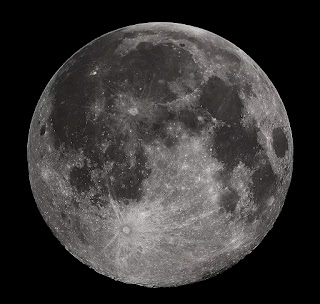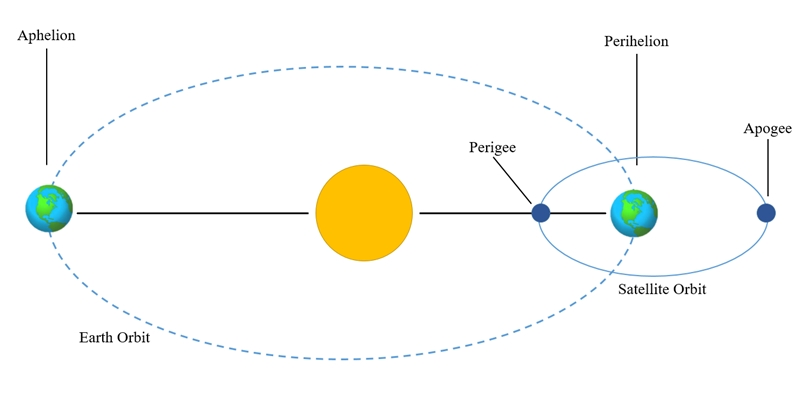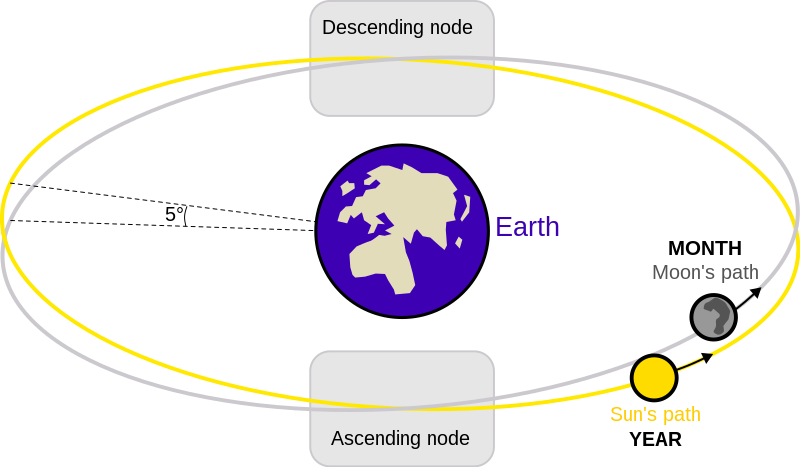Moons have been a source of wonder and awe to philosophers, scientists and the common man alike from time immemorial. Generally, we use the word 'Moon' to address our natural satellite. In astronomy, however 'moon' is considered a generic term for any celestial object moving around the parent planet. Does that mean that asteroids, meteors etc can also be classified as moons?
No. Asteroids are smaller bodies in comparison to moons. They thus lack the mass and gravity to pull their surfaces to a spherical shape. Moreover, asteroids originate from the asteroid belt while moons do not. Though this gives credible information that moons cannot be asteroids, the vice-versa is true.
The moons of Mars, Phobos and Deimos are asteroids! They originated from the asteroid belt between the orbits of Mars and Jupiter but still are considered as moons.
Figure 1: Phobos and Deimos, the moons of Mars are asteroids! FORMATION OF A MOON
There are many theories that talk about how moons formed. Let's discuss about the formation of our Moon. There are five well known theories about the formation of our Moon:
1) Capture Theory
2) Fission Theory
3) Co-Accretion Theory
4) Giant Impact Theory
5) Multiple Impact Hypothesis
1) Capture Theory:
Figure 2: Capture Theory
This was one of the most widely accepted theories regarding the formation of the solar system as well as the moon. A small chunk of matter was formed somewhere and it started drifting in space and finally got into the gravitational influence of Earth and started orbiting it.
In the case of planets, we may say that small bodies capable of forming planets called planetesimals were attracted towards a large body of intense gravitational field and combined together to form planets which later orbited around the latter.
2) Fission Theory:
Figure 3: Fission Theory
Before understanding this theory its important to know what a centrifugal force is. It is a force which is directed away from the centre of the body under consideration. Fission Theory thinks of a possibility that the Moon was once a part of Earth (within it). Due to the rapid rotation of the Earth and the accompanied centrifugal force, the encapsulated moon was thrown away and it started orbiting the planet.
3) Co-Accretion Theory:
Figure 4: Co-Accretion Theory:Believers of this theory states that Moon was formed alongside Earth during the formation of solar system. But this theory has a lot of limitations, the prominent one being the fact that Moon's age is less than that of Earth as calculated by modern scientific payloads and experiments.
4) Giant Impact Theory:
Figure 5: Giant Impact Theory
Among all the theories mentioned above, this theory is believed to be the most accurate one. It states that a giant chunk of matter (about the size of Mars) hit the Earth, 4.5 billion years ago and ejected a lot of material from the Earth which later amalgamated to form the Moon. The main reason why scientists argue that this the most accurate one lies in the fact that the isotopic composition between the rocks on Moon and that on the Earth are similar.
5) Multiple Impact Hypothesis:
It is similar to the Giant Impact Theory. Here, multiple impacts from various bodies took place and caused the formation of the moon unlike the 'single impact' in the case of the former.
EXPLORING OUR MOON
"We must also go through phases of emptiness to feel full again"
Our Moon is really special! It helps in silencing the 'wobble' of Earth on its axis without which a stable climate would not have been possible on Earth. In addition, it causes tides which is now used as a source of energy and was used extensively in navigation purposes.
Figure 6: Our Moon
Many theories suggests that our Moon in fact formed from the Earth. Citing NASA,
"Earth’s Moon is thought to have formed in a tremendous collision. A massive object ― named Theia after the mythological Greek Titan who was the mother of Selene, goddess of the Moon ― smashed into Earth, flinging material into space that became the Moon."
Moreover, when Galileo Galilei was experimenting with his telescope, he viewed the moon and found that its surface also had valleys, plains, mountains just like Earth. It were these imperfections on the Moon that prompted him to look for imperfections in the universe which finally led him to the startling yet shocking realisation that the Earth was not the centre of the Universe.
Figure 7: Galileo's own drawings citing the different phases of the moon, made during the period-November 30 to December 18, 1609.
Another interesting feature of our Moon is that it shows the same face to Earth at all times. This is due to the fact that its rotation about its own axis is in synchronisation with its revolution around the Earth.
Our Moon like other moons doesn't have a light source of its own, instead its the Sun that illuminates the Moon. Our Moon is continuously rotating and hence each the far side of the moon also receives the same amount of light as the near side of the moon, however the far side will not be visible from the Earth because of the reason mentioned earlier.
Figure 8: Far-side of our Moon.
Our Moon is the second densest moon after Jupiter's Io, however this number is relatively less in comparison to Earth. The moon has a surface gravity of around 1.62 metres per second squared against the 9.807 metres per second squared of Earth. This is the reason why Moon doesn't have an atmosphere of its own.
Just like Earth, our Moon also has day and night. Due to the absence of atmosphere it will not be able to block the incoming rays of the Sun nor will it help trap the heat during night, as a consequence the temperatures on the surface of Moon varies greatly. India's third mission to Moon, Chandrayaan 3 found that there was a difference of 50 degrees between Moon's surface and 10 cm below the surface, is an onsite experimentation of this fact.
The months on Earth are caused due to 'lunation', that is the time taken by the Moon to jump from one New Moon to the next. Altogether, 12 lunations takes place, which corresponds to 354 days, which makes up an year. Thus the people in the past established that each year consists of 12 months.
Similarly, our Moon also has its months. It has four months:
1) Anomalistic: The time taken by the Moon to completed one revolution around the Earth as measured from the point of closest approach in its orbit around Earth (perigee)
This is equal to 27 days, 13 hours, 18 minutes, 37.4 seconds.
Figure 9: Anomalistic Period with aphelion and perihelion.
2) Nodical: the time taken the Moon to pass through one of its nodes and return back to it. Node is a point where it crosses the plane of the Earth's orbit.
This is equal to 27 days, 5 hours, 5 minutes, 35.9 seconds.
The ascending (or north) node is where the Moon moves into the northern ecliptic hemisphere, while the descending (or south) node is where the Moon enters the southern ecliptic hemisphere.
Figure 10: Nodical Period
3) Sidereal: the time taken by the Moon to complete one revolution around the Earth w.r.t a reference star.
The value of 1 sidereal is equal to 29 days, 7 hours, 43 minutes, 11.5 seconds.
Figure 11: Sidereal Period
4) Synodical: the time taken by the Moon to circle the Earth using the Sun as the reference point, that is the time lapse between two successive conjunctions with the Sun - going from one new moon to the next new moon.
The value of 1 synodical period is equal to 29 days, 12 hours, 44 minutes, 2.7 seconds.
Figure 12: Lunar Synodical Period
ARE WE LOSING OUR NEIGHBOUR?
Yes. The Moon is moving away from Earth at a rate of 3.8 cm per year. It will take another 5 million years for the Moon to be so far away that Earth's gravitational influence will no longer affect the Moon: meaning it will drift away from Earth to infinity.
Portrait 1: Edmund Halley
It was Edmund Halley, an English astronomer who first scientifically showed that the Moon was drifting away from the Earth. This was experimentally confirmed when laser beams reflected back from mirrors put on the Moon by U.S and Russia showed that the rate of drifting was 3.8 cm per year.
Robert Matthews, professor at Aston University in an article to BBC talks about how this happens -
"It’s driven by the effect of the Moon’s gravity on the rotating Earth. Tides raised in the oceans cause drag and thus slow the Earth’s spin-rate. The resulting loss of angular momentum is compensated for by the Moon speeding up, and thus moving further away."
The Moon will not leave us in the immediate future but once it does it can have huge impacts on the Earth.
Just like their planet counterparts, Moons also wander in space, once in a while getting themselves held up in orbits of high gravitational fields made by a larger celestial object. In its long, endless journey, the Moon also teaches us an important lesson:
REFERENCES:
1. The Institute of Physics: Surface features of the Moon
2. Moon Formation: NASA
3.The moon- myths about our natural satellite: earthsky.org
4. Interesting facts about the Moon: Royal Museums Greenwich
5. SPACE.com
6. Ascending Node- an overview: ScienceDirect
7. Why is Moon slowly drifting away from the Earth?: The Mint
8. The Moon 'ghosting' the Earth: Is the Moon really creeping away from the Earth at an alarming rate?: Firstpost
*All the media published in this blog belongs to their original creators and 'Knowledge Through Science' does not claim any right over it.















Comments
Post a Comment